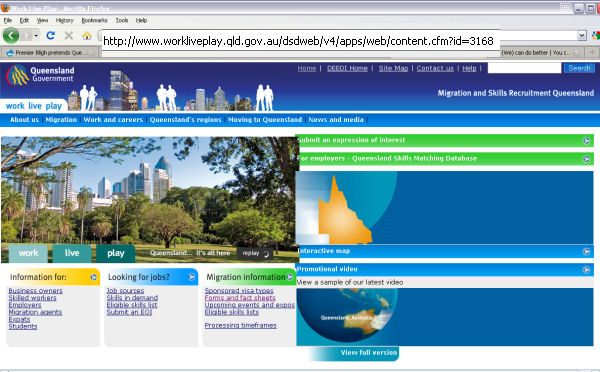
Click here to view goverment film - (note slow quicktime download 47 mb)
Anna Bigh says she cannot see, "any sensible or legal way" to cap the population.
"As attractive as a population cap sounds, I think it's misleading to imply to people that such a thing could be done," she says.
NewsComAu reports today that a Galaxy poll's results "suggest that 60 per cent of Queenslanders want the Government to take steps to limit the state's southeast population growth explosion." (Source: (Craig Johnstone and Natalie Gregg, "Queensland residents want to cap population growth," The Courier-Mail, December 07, 2009)
Misleading, irresponsible propaganda from Anna Bligh
But, although her government actively advertises for overseas and interstate immigrants, Premier Anna Bligh is quoted as saying that, "she said she was yet to see "any sensible or legal way" to cap the population. "As attractive as a population cap sounds, I think it's misleading to imply to people that such a thing could be done," she said."

Population sociologist, Sheila Newman, responds here on candobetter.org:
Premier Bligh could start by ceasing to advertise for more interstate and international immigrants.
Her statements implying that population caps are not possible are ridiculous, misleading and irresponsible. All societies have numerous democratic ways of controlling population, unless they are politically prevented from doing so by undemocratic governments like Anna Bligh's.
We have only to look at the Scandinavian and EU countries in Europe. Among the most important is the ability to limit the issue of building permits at a local level in accordance with residents' wishes. /files/qld-immigration-page-capture.jpg
Premier's stance that resistance is futile is wrong
The premier's stance seems to be that resistance is futile; the growth lobby (driven by property developers) will have it's way with us. It might suit the ALP's interests in land speculation, but it's just not true. A Premier has a duty to her constituents well-being and should be above this kind of propaganda.
The consequences of continuing to grow Queensland's population threaten the welfare of present and future generations far into the future as well as destroying Queensland's magnificent and delightful fauna and flora.
Australians should be aware that the population growth that is happening in Queensland and the rest of Australia is not democratic. It is engineered upwards by government and drives ecological damage, native animal extinction, and unaffordable cost of living.
Here is a quick lesson in how populations are controlled when societies are governed democratically.
Population Policy Battlefronts for democracy and ecological sustainability
1. Local Government
2. State Government
3. National Government
4. Global
1. Local Government
* power of limiting building permits (and thus of limiting population growth) in line with water catchment capacities, aesthetics, civil hygiene, preservation of agricultural land and natural amenities, like green wedges, nature reserves and parkland
* promotion of energy efficient public and private buildings
* facilitation of householder independence from the State power and sewerage grid
* incorporation of local indigenous species' needs for space, food and water within the concept of local planning and as participants in the regional ecology.
* residents should have self government
* local elected officials and paid staff are servants of residents and should not implement plans without their agreement
* food and fiber production should be local where possible, minimising energy used to transport goods in and out of a community
2. State Government
Wherever States have the responsibility for and power of limiting impact on the bio-regions within their borders they should exercise this within the context of national and local population policy. In Australia the states have the power over land-use and water sources and the ability and responsibility to signal when infrastructure is close to capacity. They have a number of tools for limiting urban expansion. Among these are:
*taxes on second homes, taxes on windfalls gained by sellers when land is rezoned,
*redevelopment, not new development - of old buildings, insulation of old buildings - instead of land-clearing for new construction. These taxes are there to feedback order into the allocation of construction permits and should not be relied upon as something that can be grown to subsidise increases in government spending.
*housing as a citizen's right, a state's duty and a public cost
*land-development by the state to provide low-cost land to undercut speculative private development, which raises costs through unreasonable profits, thus driving up all other costs, and providing a motive for overpopulation
- Water should not be disaggregated from land because this removes valuable biofeedback that signals limits to growth.
- State governments must be entirely transparent in all their transactions and so must the political parties in and out of government. See "John-Paul Langbroek and why the Liberal National Party won't survive unless Labor Governments reform."
- Business can only be the servant of democracy and should not dictate population limits.
- Economy is a subset of the environment.
- State governments have no business making plans for local government to follow if these are not inspected and agreed to in detail by local residents.
3. National Government
* adoption of democratic and ecologically informed population policy
* separation of political and administrative responsibility for population and immigration
* chairing of a cabinet committee on population by Prime Minister adoption of a consumption strategy
* aim to stabilise population numbers by:
- promoting small families and a
- zero net migration program - gives around 70,000 person-spaces
* plan immigration program for the humanitarian longterm, staggering intake to cope with foreseeable ongoing demands and climate change
* Change the emphasis on immigration and population research funding from its longstanding almost exclusive focus on internal migration and ethnic group demographics, in order to give far greater attention to population numbers, per capita energy use and environmental impact.
4. Global
Australia should support policies to help people to protect local controls over land-tenure, recognising that the population problems of Africa, India and the Pacific Islands, only started when colonisation dispossessed people from their local lands and stable economic traditions in homeostatic indigenous ecologies.
Australia should direct more money into foreign aid to combat the conditions that contribute to overpopulation by assisting initiatives for educating and enfranchising women, enhancing children's health, promoting family planning education and safe, non-coercive family planning methods and protecting local self-government and self-sufficiency.
Australia and other 'Developed' countries should cooperate with United Nations global initiatives in developing longsighted population policies which take into account our high environmental/energy consumption impact per capita.
As an ecologically impoverished commodity producer, Australia should lead other commodity producers by example and assist in the development and use of low energy consumption technology and lifestyle, being careful to keep its population low in conformity with the limiting characteristics of the continent's ecology and the nature of commodity dependent economies, which also do not require large volumes of workers, unless they are conducted as slave colonies to furnish cheap supply to other countries - a practice that is neither ethical, humane or sustainable.
Australia should not encourage high birth rates or high immigration without their constituents knowledge or agreement, based on useful and true information about optimal carrying capacity and the preservation of democratic rights and local empowerment.
What you can do: If you are a Queensland resident and Australian citizen, please sign the petition here.


Comments
Vivienne (not verified)
Sat, 2010-02-27 09:20
Permalink
"Talks" in Queensland about population growth
Sunshine Coast council has received 3000 submissions in its “conversation” with residents about the region’s future planning direction. And those residents overwhelmingly support a commitment to environmental protection and rehabilitation. For every developer telling the public that "we can (and must) easily accommodate another couple of million people in the greater Brisbane area", there's an environmentalist telling saying that they "cannot (and must not) put additional pressure on our natural resources".
Sustainable Population Australia (SPA) spokesman Simon Baltais says he does not expect the State Government's growth summit or the Local Government Association of Queensland's inquiry will lead to changes. He is probably right. There is so much money and short-term benefits for developers and investors who add to Federal and State government coffers. Do the people of Queensland really want SE Qld. in 20 years to look like Southern California does today? Logically, the answer should be NO.
Anna Bligh says that population density in south-east Queensland is lower than in other parts of the country and the world, and thus Queensland should follow the trend.
With the world's population blowing out to unsustainable numbers by 2050 and be expected to out-grow the supply of food and natural resources, surely as an elected leader she should be better informed and not base her policies purely on monetary concerns. More and more people are living in crowded urban areas and mega-cities, adding to greenhouse gas emissions, water scarcity, loss of biodiversity and pollution.
Southeast Queensland councils and developers claim the protection of koalas will come at the cost of 250,000 badly needed dwellings, pushing up house prices and throwing planning for population growth into chaos. There are also complaints the maps underpinning the draft Koala Conservation Plan are highly inaccurate. (Maybe they are now just so few and far apart?) University of Queensland Professor Frank Carrick said there was plenty of development land left but if houses had to be cut to save koalas, then it would have to be done. He said that koalas may disappear in a few years. "We're not talking decades."
("Inaccurate maps protect wrong areas as koala habitat" by Sarah Vogler and Brian Williams in the Courier-Mail of 26 Feb 10)
The irony is that person who kills a koala with two slug gun pellets risks a fine of $300,000 and two years’ jail, as in the case of Doug the baby koala, but our state infrastructure planners can destroy koala habitat with apparent impunity.
A study from the Australian Sustainable Built Environment Council says greenhouse gas emissions from transport are on track to skyrocket 75 per cent within 30 years – worse than in Melbourne.
Brisbane's Lord Mayor Campbell Newman said there needed to be more federal involvement in the future growth of the state's south-east corner. He also questioned the validity of the 'Big Australia' proposal, where the national population will grow to 35 million by the middle of this century. Sunshine Coast mayor Bob Abbot - a vocal critic of over-population - agreed the federal government needed to provide more information about the benefits of Big Australia. The "benefits" will be mainly for a few elite who will have the financial resources to buffer themselves from the misery of the masses!
Anna Bligh does not have to be a victim of Federal immigration policies that she denies she has any control over.
The lure of population growth is based on short-term financial gain and ignores the long term concerns of exponential growth, which few of us really comprehend. The protection of the Australian way of life - how we enjoy living in The Lucky Country - should be of paramount concern to our leaders, not just creating a bigger tax-base!
With the creation of the Stable Population Party of Australia, the vital concern of population growth should become an election issue next November.
Add comment